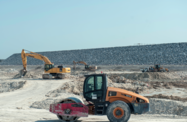A quick scan down the list of strategic projects currently getting underway in Qatar reveals not only the enormous scale of construction, but also the size of the state’s project financing commitments.
From the QR136.5bn Qatar Rail roll out to the comparatively modest QR20bn and QR30bn sums attached to Education City, Musheireb, Barwa City and the World Cup stadiums, the project list accounts for a major section of the globe’s current construction pipeline.
This size factor has been causing some furrowed brows recently though given that this local construction drive is coming at a time when the world as a whole looks a lot less financially confident.
In mid-April, for example, China announced its lowest GDP growth since 2009. Still a healthy 7%, this was nonetheless taken by most analysts as worrying, especially given other global factors. These include growing deflation in Europe, IMF concerns of emerging market slowdowns, and the on-going effects of ending quantitative easing in the US – including the potential impact on markets of the Fed raising interest rates.
Of particular relevance for the region – and impacting Qatar too – has been the collapse in oil prices, which tumbled from a high of $114.77 a barrel in June 2014 to a low of $46.18 around the year’s end. Prices have since risen again, to around $58 a barrel, yet this has had a major impact on what is still an important income earner for Qatar. This price decline is now also beginning to impact Qatar’s main hydrocarbon earner, liquefied natural gas (LNG).
Lower hydrocarbons prices also adversely affected sentiment at the Qatar Stock Exchange (QSE), which was already negatively impacted by regional tensions. At the same time, the Qatar Central Bank (QCB) has been obliged to defend the Qatari Riyal (QR) over the last year, as the US dollar – to which it is pegged – has appreciated. Between November 2014 and January 2015, this led to a QR19.6bn drop in net international reserves.
All of these factors added together would ordinarily cause considerable alarm in the project financing world. The Qatari state’s revenues have fallen along with the QCB’s reserves, while the stock market has also taken a plunge. Meanwhile, a tightening global market tends to make international financiers a lot more risk averse. With such a large infrastructure project roll out going on, cut backs and revisions would therefore ordinarily be expected.
Yet, this has not been the case in Qatar. Why? Well, the central reason is the huge financial reserves that the country continues to have access to.
For the last several years, Qatar has recorded significant budget surpluses, building up a diversified savings and investments portfolio both at home and around the world. The state’s current account has also recorded surpluses for many years, with the QCB easily able to take actions such as its recent defence of the Riyal.
There is also considerable momentum in the economy as a result of major project investments in previous years and organic population growth. The latter expanded 9.5% in the year March 2014-March 2015, while real GDP growth hit 6.7% in 4Q14, according to Qatar National Bank (QNB) figures. That quarter, non-hydrocarbon sector growth reached 10.3% – with construction and services the main growth engines.
This level of expansion is reflected in the fact that Qatar’s banks have seen very little change in their deposit bases – or any shift away from the Riyal to foreign exchange. A graph of total deposits over the last year shows almost no fluctuation, despite oil prices tumbling, the dollar strengthening, and regional turbulence increasing. This also shows the level of confidence there is in the Qatari banking system.
At the same time, with LNG being Qatar’s main hydrocarbons sector earner, the state has been partly protected from falling oil prices. LNG is generally sold according to long-term contracts and off-take deals designed to smooth out short-term price fluctuations. These arrangements are progressively coming to an end, but until now, they have helped cushioned the oil price blow. So, while 2014 saw hydrocarbon revenues fall – their contribution to the state budget going from $65bn in 2013 to $62bn in 2014 and an IMF forecast of $60bn in 2015-16 – the country will still make around $372bn in revenue from hydrocarbons over the next five years.
Thus, while recent events have undoubtedly impacted Qatar’s financial strength, the country is well cushioned to avoid any major damage.
What budgetary adjustments there have been may also have long-term benefits for project finance.
In an interview to be published in OBG’s upcoming The Report: Qatar 2015, the CEO of the Commercial Bank of Qatar (CBQ), Abdulla Salah Al Raisi, said that more optimised fiscal budgeting as a result of recent falls in revenue would actually lead to more sustainable and efficient project management.
All of these factors make Qatar quite an exceptional market – with the government set to continue its well financed project roll out unabated in the years ahead.
--This original article from OBG originally appeared in Qatar's Construction News, Yearbook 2015 issue.

